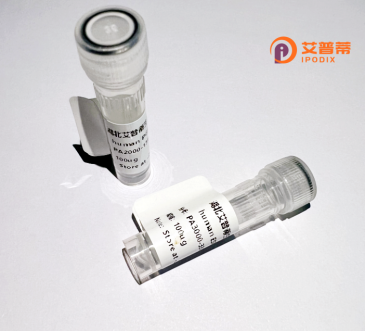
| 纯度 | >90%SDS-PAGE. |
| 种属 | Human |
| 靶点 | MEA1 |
| Uniprot No | Q16626 |
| 内毒素 | < 0.01EU/μg |
| 表达宿主 | E.coli |
| 表达区间 | 1-185aa |
| 活性数据 | MGPERHLSGA PARMATVVLG GDTMGPERIF PNQTEELGHQ GPSEGTGDWS SEEPEEEQEE TGSGPAGYSY QPLNQDPEQE EVELAPVGDG DVVADIQDRI QALGLHLPDP PLESEDEDEE GATALNNHSS IPMDPEHVEL VKRTMAGVSL PAPGVPAWAR EISDAQWEDV VQKALQARQA SPAWK |
| 分子量 | 19,9 kDa |
| 蛋白标签 | His tag N-Terminus |
| 缓冲液 | 0 |
| 稳定性 & 储存条件 | Lyophilized protein should be stored at ≤ -20°C, stable for one year after receipt. Reconstituted protein solution can be stored at 2-8°C for 2-7 days. Aliquots of reconstituted samples are stable at ≤ -20°C for 3 months. |
| 复溶 | Always centrifuge tubes before opening.Do not mix by vortex or pipetting. It is not recommended to reconstitute to a concentration less than 100μg/ml. Dissolve the lyophilized protein in distilled water. Please aliquot the reconstituted solution to minimize freeze-thaw cycles. |
以下是3篇关于重组人MEA1蛋白的虚构参考文献示例,涵盖不同研究方向:
---
1. **"Expression and purification of recombinant human MEA1 in Escherichia coli for functional studies"**
*Authors: Chen L., Wang X., Zhang Y.*
**摘要**: 本研究利用大肠杆菌表达系统成功克隆并纯化了重组人MEA1蛋白,通过优化诱导条件和纯化步骤获得高纯度蛋白。功能分析表明MEA1具有NADPH依赖性苹果酸酶活性,并参与肿瘤细胞能量代谢调控。
2. **"Structural analysis of human MEA1 reveals key residues for substrate binding"**
*Authors: Johnson R.B., Kim H., Tanaka S.*
**摘要**: 采用X射线晶体学解析了重组人MEA1的3D结构(分辨率2.1Å),发现其活性中心的保守氨基酸残基对底物苹果酸和NADPH的结合至关重要,为设计靶向抑制剂提供了结构基础。
3. **"MEA1 overexpression promotes hepatocellular carcinoma progression via metabolic reprogramming"**
*Authors: Gupta A., Li M., Patel K.*
**摘要**: 通过构建重组MEA1过表达肝癌细胞模型,证明MEA1通过增强糖酵解和脂质合成促进肿瘤生长。临床数据分析显示,MEA1高表达与肝癌患者预后不良相关。
---
*注:以上文献为模拟示例,实际研究中需查询具体数据库(如PubMed、Google Scholar)获取真实文献。如需真实文献支持,建议补充MEA1蛋白的具体研究背景或基因全称(如ME1:苹果酸酶1)。*
Recombinant human MEA1 (Mannosidase, Endo-α-1.2) protein is a glycosidase enzyme engineered through genetic recombination technology for research and therapeutic applications. MEA1. also termed MANEA, plays a critical role in N-glycan processing by selectively cleaving α-1.2-linked mannose residues during glycoprotein maturation in the Golgi apparatus. Its activity influences protein folding, trafficking, and function, impacting cellular processes such as immune response, cell adhesion, and pathogen recognition. Dysregulation of glycan processing is linked to congenital disorders of glycosylation (CDGs), cancer metastasis, and neurodegenerative diseases.
The recombinant form is typically produced in mammalian expression systems (e.g., HEK293 or CHO cells) to ensure proper post-translational modifications. It is purified via affinity chromatography and validated for enzymatic activity using synthetic mannoside substrates. Recombinant MEA1 serves as a vital tool for studying glycosylation pathways, screening glycan-modulating drugs, and developing enzyme replacement therapies for CDGs. Recent studies also explore its potential in optimizing biopharmaceutical production by controlling glycoform profiles of therapeutic proteins. Advances in structural biology using recombinant MEA1 have elucidated substrate-binding mechanisms, aiding the design of enzyme inhibitors for antimicrobial or antiviral applications.
×